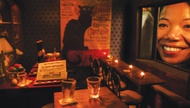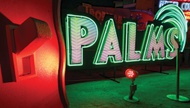A city tells a million stories, each separated by degrees. As the Biscuit Street Preacher, Las Vegan Robbie Martin is a self-appointed, Southern-bred missionary casting a working man’s eye to the streets. In Pep Rally at Trifecta Gallery, the Preacher uses large-scale paintings to evangelize the everyday, sometimes with quite fantastical results.
At first glance, the paintings appear markedly familiar. A swift and easy comparison can be made to the vernacular of Jean-Michel Basquiat, and, frankly, it would be irresponsible to neglect the similarities. Like a Stuart Davis for the 1980s Lower East Side, Basquiat demonstrated a unique confluence of graffiti-inflected style with pop-like iconography that has come to signify a very particular landscape: the American City. Akin to early Robert Rauschenberg in his reliance on very personal detritus, Basquiat also mined the streets and various cultures for remnants of real life. Rough and raw, these elements granted a grittily glorious urgency to his paintings. The Preacher’s syncopated compositions and thickly textured surfaces only stress this comparison. Naïve mark-making? Check. Jazzy structure? Check. A mixture of abstract shapes and urban imagery? Check. This, then, must be an inner-city scene!
The comparisons end there. You can’t blame a guy for tapping into what is now a standardized collection of aesthetic devices to convey a particular sense of place, context or psychology. But where Basquiat employed intensely personal abstract symbols and text, the Preacher shares a particularly generous brand of representation. This universality is one of the great assets of the work, allowing for instantaneous access to an already terrifically narrative viewing experience.
The Details
- Pep Rally

- Through June 28, Trifecta Gallery.
- 107 E. Charleston #160 (inside the Arts Factory).
- 366-7001
- Beyond the Weekly
- Biscuit Street Preacher
In paintings like “Top Two Floors” and “Bust One Wins,” the Biscuit Street Preacher takes very recognizable elements and combines them into lively stories with a twist. Some are quite direct, as in “Used Appliances for Sale”; others are a bit more open-ended. In “Fotos,” a photo booth sits in the middle distance while partially obscured photo strips peopled with deftly rendered cartoon faces flatten the air above it. These elements are direct enough, until you arrive at what appear to be clocks or meters defining the top edge of the painting. The layered play with dimensionality and proximity (long distance view of booth, two-dimensional photos, close-up of clocks/meters, long stretches of thick, flat paint) hints at a narrative of time—unless of course the round objects are actually utility meters. Then a completely different story emerges, one of a snapshot into the inner workings of the booth, or maybe even the mall itself, and the secreted system of workers and utilities and machines and … well, you get the idea.
This work is about stories. When you walk down the street, do you ever make up histories about the people and things you see? The Preacher seems to do exactly that: Beginning with whatever captures his curious eye, he spins a yarn that tumbles onto the surface of the paintings. Unfettered, brimming with stream-of-consciousness imagery and style, these stories rambunctiously defy linearity while the naïve style conveys urgent sincerity.
That said, the work is not without its problems. The artist undeniably spins a great yarn, but this Preacher is not writing short stories; he is making paintings, and at this juncture his style feels a bit derivative. Seemingly free of self-censorship and completely visceral in a romantically expressionistic sort of way, the paintings might benefit from a more considered application of media and materials and a general tightening of focus.
Although it’s passionately painted, more than once I found the Biscuit Street Preacher’s work indistinguishable from that of various others’ of a similar style. What sets this Preacher apart? What is his singular voice? To be fair, the artist appears to be in a phase of rapid growth, and this experimentation is part of the fun. In “Skeeball,” he flattens illusionistic space entirely, transforming the painting field into the midway-game surface itself. But the addition of a large metal element to the perimeter of the painting distracts rather than reinforces this object-ness. There is a lot happening, and more work is necessary to tie it with a bow.
Even so, as the Biscuit Street Preacher expands his vision, it will be thrilling to see how he grows as an artist and how his visual filtration of the city evolves over time.
Pep Rally aaacc Through June 28, Trifecta Gallery, 107 E. Charleston #160 (inside the Arts Factory), 366-7001.





Previous Discussion: